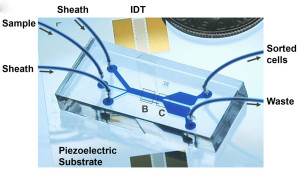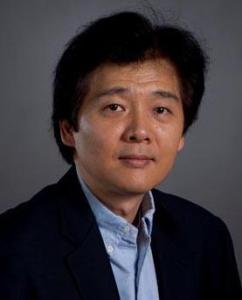Innovative device uses acoustic sound waves to gently separate circulating cancer cells from white blood cells
In many respects, the ability to separate and identify circulating tumor cells (CTCs) is one of the holy grails of cancer diagnostics. It is widely believed that a clinical laboratory test that can effectively identify CTCs would contribute to earlier detection of cancer and improved outcomes for caner patients.
Pathologists will be interested to learn about a useful new tool that can flag circulating tumor cells. Researchers say that this approach enables them to determine if a cancerous tumor is going to spread, without tagging tumor cells with harsh chemicals. This gentler alternative to current diagnostic methods involves an innovative device that uses “tilted” sound waves to sort tumor cells from white blood cells, noted a report in Headlines & Global News.
This device is about the size of a cell phone. It was developed by a team of scientists from the Pennsylvania State University (PSU), Massachusetts Institute of Technology (MIT) and Carnegie Mellon University (CMU).
Their research was funded by the National Institutes of Health (NIH) and the National Science Foundation (NSF). The research study was published by PNAS, the journal of the U.S. National Academy of Sciences, January 5, 2015.
Tilting Sound Waves Offers Way to Detect Circulating Tumor Cells

Above is a schematic that shows the principle behind the device that uses tilted-angle, standing surface, acoustic sound waves to separate tumor cells from white blood. (Copyright Tony Huang/Penn State University)
“For biological testing we often need to do cell separation before analysis,” said Tony Jun Huang, Ph.D., PSU Professor of Engineering Science and Mechanics in an article posted on PSU’s website. “But if the separation process affects the integrity of the cells, damages them in any way, the diagnosis often won’t work well.”
Sound waves offer a precise way to sort cells without having to expose them to chemicals or damaging forces, noted Ming Dao, Ph.D., MIT Principal Investigator & Director of the Nanomechanics Laboratory and a Principle Research Scientist in the Department of Materials Science and Engineering. Dao was co-senior author of the research paper. “Acoustic pressure is very mild and much smaller in terms of forces and disturbance to the cell,” he said. “This is a most gentle way to separate cells, and there’s no artificial labeling necessary.”

One of the researchers developing new technology to identify circulating tumor cells in blood is Ming Dao, Ph.D. (pictured above). He is Principal Investigator and Director of the Nanomechanics Laboratory at the Massachusetts Institute of Technology. Dao and his research collaborators are using acoustic sound waves to separate cancer cells from other cells in human blood. (Photo copyright by Massachusetts Institute of Technology.)
According to the PSU article, “Unlike conventional separation methods that centrifuge for 10 minutes at 3,000 revolutions per minute, the surface acoustic waves can separate cells in a much gentler way. The power intensity and frequency used in this study are similar to that used in ultrasonic imaging, which has proven to be extremely safe, even for fetuses. Also, each cell experiences the acoustic wave for only a fraction of a second, rather than 10 minutes.”
How Sound Wave-based Cell Separation Works
Exposure to sound waves can slightly deflect the flow of a mixture of cells or particles traveling in one direction, but the amount of deflection is determined by cells’ physical properties, including size and compressibility, explained a report published by Medical News Today.
Earlier attempts by scientists to sort cells using sound waves involved using microfluidic acoustic devices to form standing waves to produce a line of low pressure that runs parallel to the direction of cell flow, noted MIT in an article published on its website. When the cells encountered the low-pressure areas, or nodes, they were deflected to the side. The results, however, were deemed inefficient because only one node could be created at a time, and because the cells could only be deflected short distances.
But by tilting the sound waves, the cells travel at angles across the microchannels. Then, as the cells move through the microchannels, they encounter several nodes that nudge them further and further off center, enabling the device to sort them by size.

The image above illustrates sound waves sorting cancer cells from blood without exposing them to chemicals or damaging forces. (Copyright Christine Daniloff/MIT.)
“That is just enough to make cells of different sizes and properties separate from each other without causing any damage or harm to them,” said Taher Saif, Ph.D., a Professor of Mechanical Science and Engineering at the University of Illinois at Urbana-Champaign, in the MIT article.
Testing the Accuracy of the Cell Separation System
The PCU/MIT/CMU scientists first used tilted sound waves to separate plastic 9.9-micron diameter beads from similar beads that had 7.3-micron diameters. That initial test resulted in a 97% accuracy rate. By adding a computer simulation module capable of predicting a cell’s trajectory through the channel based on its size, density, compressibility, and angle of the sound waves, the team further refined the device, thus demonstrating that the devices was capable of separating cells of different types.
The scientists’ then attempted to separate breast cancer cells from white blood cells, which differ in size by about 8 microns, in addition to having different density and compressibility. The device was 71% accurate.
The researchers next plan is to test the device’s accuracy using blood samples from cancer patients to see how effectively it can detect circulating tumor cells in clinical settings, stated the MIT article. If that next step is successful and clinical studies validate the accuracy of this diagnostic approach, pathologists can expect to see this system for separating tumor cells from blood replace current methods for detecting circulating cancer cells in blood.
—Patricia Kirk
Related Information:
Cell Separation Using Tilted-Angle Standing Surface Acoustic Waves
Sorting Cells with Sound Waves
Sound Waves Separate Tumor and Blood Cells
Sound Waves Could Be Used to Separate Cancer Cells from Blood



